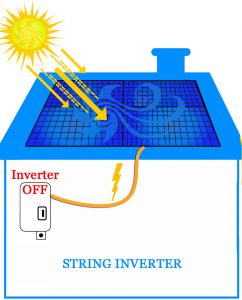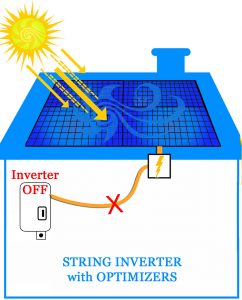The time between your solar energy system being installed and when you can turn the system on is the hardest waiting period for any new solar owner. Your system is there, ready and willing to produce clean energy for you, but you can’t power it up until the utility says okay.
So what is it actually doing while it sits there waiting? Are the panels producing power? If yes, where is it going? Is a bunch of solar energy zinging around your house?
When your panels are fully installed and wired, and sunlight hits their photovoltaic cells, potential energy is created. But don’t worry – it’s not like that energy is desperately looking for a place to go. It sits there in a constant state waiting to be released when the inverter says “go”. It’s not dangerous. You won’t see arcing or sparks.
It’s similar to the water in your kitchen sink. When the faucet is off, the water sits there in the pipes, ready to be used, but not causing any issues.
Unlike your kitchen pipes, which have H2O molecules flowing in them, there is nothing moving in your solar wiring. No solar-generated electrons are bouncing around. The electrons don’t flow unless there is a path to ground (or lower potential, but for simplicity, I’ll just refer to path to ground). When the inverter is off, there is no path to ground — nowhere for the power to go.
Technically, though, your wires are “live” – cutting into one would create a path to ground and the electricity would flow to you, shocking or even electrocuting you, so please treat your solar wires and panels respectfully, even if the system hasn’t been turned on yet.
Incidentally, this same potential energy situation occurs in a power outage, if the sun is shining.
Which parts of your solar energy system have this potential energy stored in them? That depends on your system.
If you have a standard string inverter, like the Solectria ones we sold for many years, all the wiring from the panels on the roof to the inverter houses potential energy and thus is live. That’s why the wiring is housed in metal conduit, to protect you (and to protect it from physical damage).
If you have a SolarEdge inverter with optimizers under each panel, or micro-inverters, like the ones we’ve installed for many customers, the solar energy travels the short distance from the panel to the optimizer or micro-inverter, and stops there. The wires from the roof into your home are not energized and have no potential energy.
This capability to prevent potential energy from hanging around in the wires in your house was first required in the 2014 electrical code. Today, this functionality is built into inverter technology, to protect first responders working on properties with solar.
If you liked this article, you might also enjoy:






